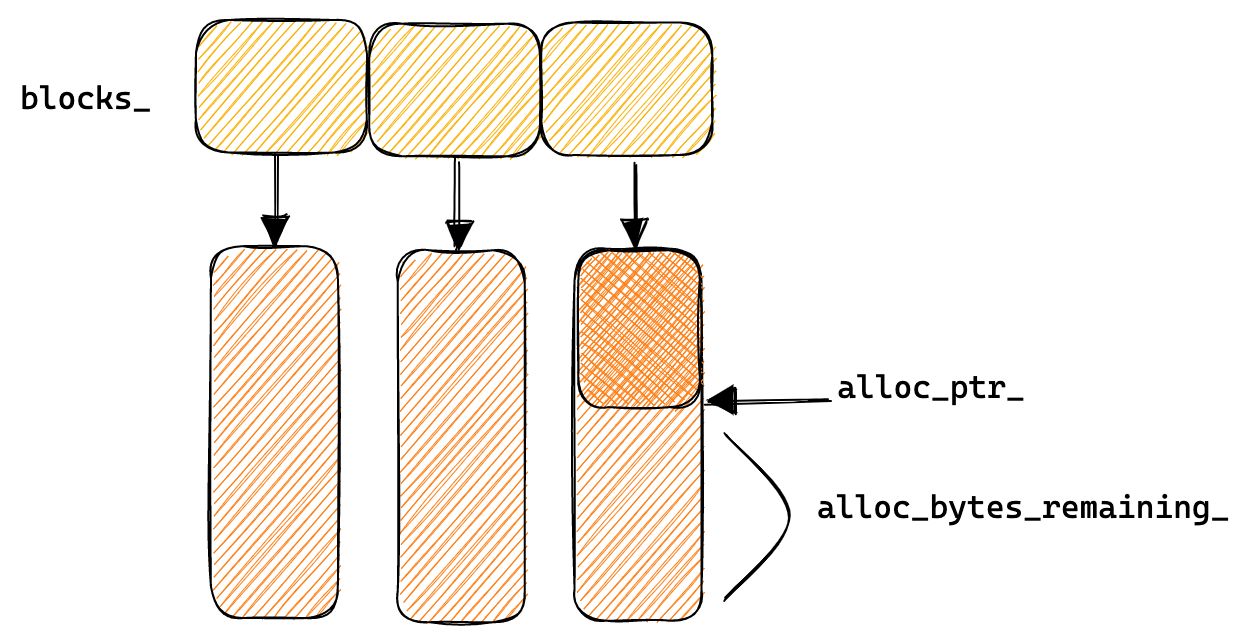内存池的主要作用是减少 malloc 和 new 的次数,因为每次内存分配都需要经过系统调用,这种开销是十分巨大的,所以通过内存池可以减少这种开销。
Leveldb 的内存池代码放在 util/arena.cc 和 util/arena.h 中。
1
2
3
4
5
6
7
8
9
10
11
12
13
14
15
16
17
18
19
| class Arena {
public:
// ...
private:
// ...
// Allocation state
char* alloc_ptr_;
size_t alloc_bytes_remaining_;
// Array of new[] allocated memory blocks
std::vector<char*> blocks_;
// Total memory usage of the arena.
//
// TODO(costan): This member is accessed via atomics, but the others are
// accessed without any locking. Is this OK?
std::atomic<size_t> memory_usage_;
};
|
alloc_ptr_ 指向的是内存块中未分配内存的其实地址的指针
alloc_bytes_remaining_ 记录当前内存块未分配内存的大小
blocks_ 申请到的内存块
memory_usage_ 内存使用量
如下图所示:

Arena 的内存分配策略有三种:
- 如果
bytes 小于等于当前内存块的剩余内存时候,直接在当前内存块上分配内存 - 如果
bytes 大于当前内存块剩余内存时候,调用 AllocateFallback 函数分配内存- 如果
bytes 小于等于默认内存块大小的四分之一,新申请一个内存块,大小为默认内存块大小。 - 如果
bytes 大于默认内存块大小的四分之一,新申请一个内存块,大小为 bytes,分配内存。
1
2
3
4
5
6
7
8
9
10
11
12
13
14
15
16
| inline char* Arena::Allocate(size_t bytes) {
// The semantics of what to return are a bit messy if we allow
// 0-byte allocations, so we disallow them here (we don't need
// them for our internal use).
assert(bytes > 0);
// When the bytes is less than alloc_bytes_remaining_,
// we allocate the memory in this block.
if (bytes <= alloc_bytes_remaining_) {
char* result = alloc_ptr_;
alloc_ptr_ += bytes;
alloc_bytes_remaining_ -= bytes;
return result;
}
// we need a new memory block.
return AllocateFallback(bytes);
}
|
Allocate 使用了内联,减小函数调用的开销。
1
2
3
4
5
6
7
8
9
10
11
12
13
14
15
16
17
| char* Arena::AllocateFallback(size_t bytes) {
if (bytes > kBlockSize / 4) {
// Object is more than a quarter of our block size. Allocate it separately
// to avoid wasting too much space in leftover bytes.
char* result = AllocateNewBlock(bytes);
return result;
}
// We waste the remaining space in the current block.
alloc_ptr_ = AllocateNewBlock(kBlockSize);
alloc_bytes_remaining_ = kBlockSize;
char* result = alloc_ptr_;
alloc_ptr_ += bytes;
alloc_bytes_remaining_ -= bytes;
return result;
}
|
根据 bytes 的大小去 allocate 新的内存块,调用 AllocateNewBlock
1
2
3
4
5
6
7
| char* Arena::AllocateNewBlock(size_t block_bytes) {
char* result = new char[block_bytes];
blocks_.push_back(result);
memory_usage_.fetch_add(block_bytes + sizeof(char*),
std::memory_order_relaxed);
return result;
}
|
分配新的内存块就是 new 一个新的内存空间,然后存入 blocks_,然后增加 memory_usage_ 的值。
leveldb 还提供了另外一个内存对齐的分配方式:AllocateAligned
1
2
3
4
5
6
7
8
9
10
11
12
13
14
15
16
17
18
19
20
21
22
23
24
25
26
27
28
29
30
| char* Arena::AllocateAligned(size_t bytes) {
// 计算当前机器要对齐的字节数,最多 8 字节对齐,否则就按照当前机器的 void* 的大小来对齐
const int align = (sizeof(void*) > 8) ? sizeof(void*) : 8;
// 字节对齐必须是 2 的次幂
// x & (x - 1) = 0 表示 x 是 2 的次幂
static_assert((align & (align - 1)) == 0,
"Pointer size should be a power of 2");
// A & (B - 1) = A % B
// reinterpret_cast<uintptr_t> 类型对应机器指针大小
size_t current_mod = reinterpret_cast<uintptr_t>(alloc_ptr_) & (align - 1);
// 如果 current_mod = 0 表示 alloc_ptr_ 已经是字节对齐的
// 否则计算 align - current_mod,表示当前指针地址距离字节对齐的偏差
size_t slop = (current_mod == 0 ? 0 : align - current_mod);
// 当前需要分配的字节大小加上对齐偏差就是最终需要分配的总大小
size_t needed = bytes + slop;
char* result;
// 所需的内存小于当前内存块剩余的内存,直接在当前内存块上分配内存
if (needed <= alloc_bytes_remaining_) {
result = alloc_ptr_ + slop;
alloc_ptr_ += needed;
alloc_bytes_remaining_ -= needed;
} else {
// AllocateFallback always returned aligned memory
result = AllocateFallback(bytes);
}
// 保证分配的内存起始地址是字节对齐的
assert((reinterpret_cast<uintptr_t>(result) & (align - 1)) == 0);
return result;
}
|
